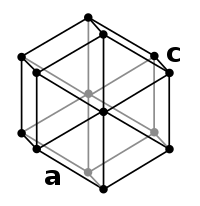
Photo from wikipedia
Metal promotion in heterogeneous catalysis requires nanoscale-precision architectures to attain maximized and durable benefits. Herein, we unravel the complex interplay between nanostructure and product selectivity of nickel-promoted In 2 O… Click to show full abstract
Metal promotion in heterogeneous catalysis requires nanoscale-precision architectures to attain maximized and durable benefits. Herein, we unravel the complex interplay between nanostructure and product selectivity of nickel-promoted In 2 O 3 in CO 2 hydrogenation to methanol through in-depth characterization, theoretical simulations, and kinetic analyses. Up to 10 wt.% nickel, InNi 3 patches are formed on the oxide surface, which cannot activate CO 2 but boost methanol production supplying neutral hydrogen species. Since protons and hydrides generated on In 2 O 3 drive methanol synthesis rather than the reverse water-gas shift but radicals foster both reactions, nickel-lean catalysts featuring nanometric alloy layers provide a favorable balance between charged and neutral hydrogen species. For nickel contents >10 wt.%, extended InNi 3 structures favor CO production and metallic nickel additionally present produces some methane. This study marks a step ahead towards green methanol synthesis and uncovers chemistry aspects of nickel that shall spark inspiration for other catalytic applications. Palladium-promoted indium oxide is a catalyst with potential to realize the large-scale conversion of CO 2 into the commodity methanol. This work focuses on the low-cost nickel as an alternative appealing promoter, revealing the atomic-level catalyst design unlocking maximal selectivity and activity.
Journal Title: Nature Communications
Year Published: 2021
Link to full text (if available)
Share on Social Media: Sign Up to like & get
recommendations!